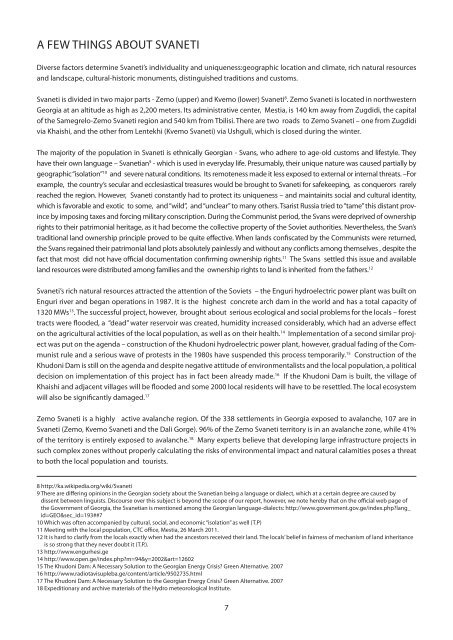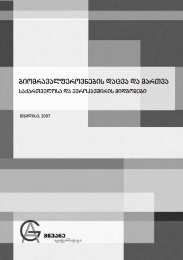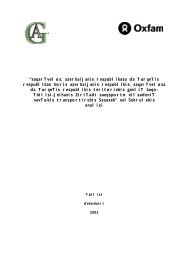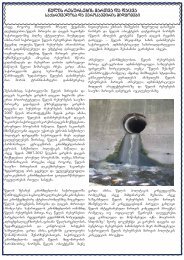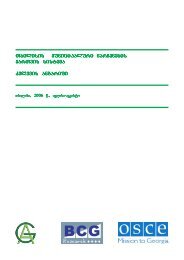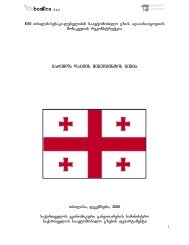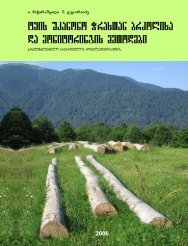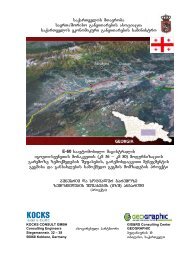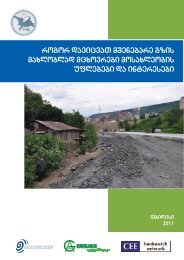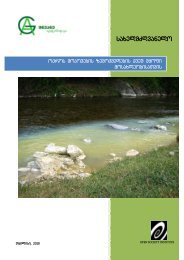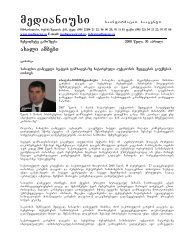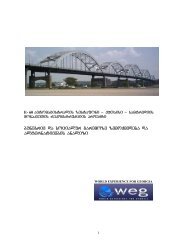The case of Mestia
The case of Mestia
The case of Mestia
- No tags were found...
You also want an ePaper? Increase the reach of your titles
YUMPU automatically turns print PDFs into web optimized ePapers that Google loves.
A FEW THINGS ABOUT SVANETIDiverse factors determine Svaneti’s individuality and uniqueness:geographic location and climate, rich natural resourcesand landscape, cultural-historic monuments, distinguished traditions and customs.Svaneti is divided in two major parts - Zemo (upper) and Kvemo (lower) Svaneti 8 . Zemo Svaneti is located in northwesternGeorgia at an altitude as high as 2,200 meters. Its administrative center, <strong>Mestia</strong>, is 140 km away from Zugdidi, the capital<strong>of</strong> the Samegrelo-Zemo Svaneti region and 540 km from Tbilisi. <strong>The</strong>re are two roads to Zemo Svaneti – one from Zugdidivia Khaishi, and the other from Lentekhi (Kvemo Svaneti) via Ushguli, which is closed during the winter.<strong>The</strong> majority <strong>of</strong> the population in Svaneti is ethnically Georgian - Svans, who adhere to age-old customs and lifestyle. <strong>The</strong>yhave their own language – Svanetian 9 - which is used in everyday life. Presumably, their unique nature was caused partially bygeographic “isolation” 10 and severe natural conditions. Its remoteness made it less exposed to external or internal threats. –Forexample, the country’s secular and ecclesiastical treasures would be brought to Svaneti for safekeeping, as conquerors rarelyreached the region. However, Svaneti constantly had to protect its uniqueness – and maintainits social and cultural identity,which is favorable and exotic to some, and “wild”, and “unclear” to many others. Tsarist Russia tried to “tame” this distant provinceby imposing taxes and forcing military conscription. During the Communist period, the Svans were deprived <strong>of</strong> ownershiprights to their patrimonial heritage, as it had become the collective property <strong>of</strong> the Soviet authorities. Nevertheless, the Svan’straditional land ownership principle proved to be quite efective. When lands coniscated by the Communists were returned,the Svans regained their patrimonial land plots absolutely painlessly and without any conlicts among themselves , despite thefact that most did not have oicial documentation conirming ownership rights. 11 <strong>The</strong> Svans settled this issue and availableland resources were distributed among families and the ownership rights to land is inherited from the fathers. 12Svaneti’s rich natural resources attracted the attention <strong>of</strong> the Soviets – the Enguri hydroelectric power plant was built onEnguri river and began operations in 1987. It is the highest concrete arch dam in the world and has a total capacity <strong>of</strong>1320 MWs 13 . <strong>The</strong> successful project, however, brought about serious ecological and social problems for the locals – foresttracts were looded, a “dead” water reservoir was created, humidity increased considerably, which had an adverse efecton the agricultural activities <strong>of</strong> the local population, as well as on their health. 14 Implementation <strong>of</strong> a second similar projectwas put on the agenda – construction <strong>of</strong> the Khudoni hydroelectric power plant, however, gradual fading <strong>of</strong> the Communistrule and a serious wave <strong>of</strong> protests in the 1980s have suspended this process temporarily. 15 Construction <strong>of</strong> theKhudoni Dam is still on the agenda and despite negative attitude <strong>of</strong> environmentalists and the local population, a politicaldecision on implementation <strong>of</strong> this project has in fact been already made. 16 If the Khudoni Dam is built, the village <strong>of</strong>Khaishi and adjacent villages will be looded and some 2000 local residents will have to be resettled. <strong>The</strong> local ecosystemwill also be signiicantly damaged. 17Zemo Svaneti is a highly active avalanche region. Of the 338 settlements in Georgia exposed to avalanche, 107 are inSvaneti (Zemo, Kvemo Svaneti and the Dali Gorge). 96% <strong>of</strong> the Zemo Svaneti territory is in an avalanche zone, while 41%<strong>of</strong> the territory is entirely exposed to avalanche. 18 Many experts believe that developing large infrastructure projects insuch complex zones without properly calculating the risks <strong>of</strong> environmental impact and natural calamities poses a threatto both the local population and tourists.8 http://ka.wikipedia.org/wiki/Svaneti9 <strong>The</strong>re are difering opinions in the Georgian society about the Svanetian being a language or dialect, which at a certain degree are caused bydissent between linguists. Discourse over this subject is beyond the scope <strong>of</strong> our report, however, we note hereby that on the oicial web page <strong>of</strong>the Government <strong>of</strong> Georgia, the Svanetian is mentioned among the Georgian language-dialects: http://www.government.gov.ge/index.php?lang_id=GEO&sec_id=193##710 Which was <strong>of</strong>ten accompanied by cultural, social, and economic “isolation” as well (T.P)11 Meeting with the local population, CTC oice, <strong>Mestia</strong>, 26 March 2011.12 It is hard to clarify from the locals exactly when had the ancestors received their land. <strong>The</strong> locals’ belief in fairness <strong>of</strong> mechanism <strong>of</strong> land inheritanceis so strong that they never doubt it (T.P.).13 http://www.engurhesi.ge14 http://www.open.ge/index.php?m=94&y=2002&art=1260215 <strong>The</strong> Khudoni Dam: A Necessary Solution to the Georgian Energy Crisis? Green Alternative. 200716 http://www.radiotavisupleba.ge/content/article/9502735.html17 <strong>The</strong> Khudoni Dam: A Necessary Solution to the Georgian Energy Crisis? Green Alternative. 200718 Expeditionary and archive materials <strong>of</strong> the Hydro meteorological Institute.7


